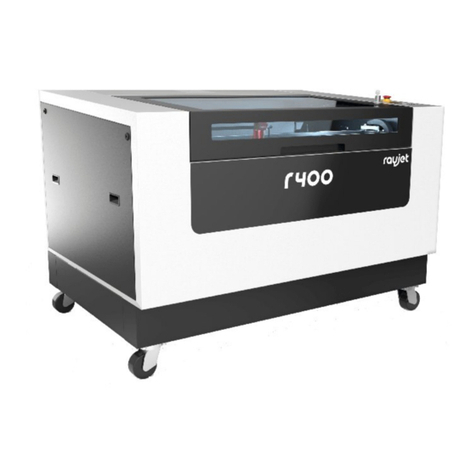
Service Manual Rayjet
Table of contents
1MAIN COMPONENTS ......................................................................................... 5
2SAFETY INFORMATION..................................................................................... 6
2.1 General .......................................................................................................................................6
2.2 Laser Safety ...............................................................................................................................8
2.2.1 Safety Interlock System....................................................................................................... 9
2.3 Dangers of Electricity..............................................................................................................10
2.4 Emission indication and safety labeling ...............................................................................11
2.4.1 Light Emitting Diodes......................................................................................................... 11
2.4.2 Audible Warning ................................................................................................................ 11
2.4.3 Safety Labels..................................................................................................................... 11
3BEAM ALIGNMENT .......................................................................................... 12
3.1 Laser beam alignment.............................................................................................................12
3.2 Laser pointer adjustment........................................................................................................16
4REPLACING THE LASER TUBE ...................................................................... 17
4.1 Measuring the laser power:....................................................................................................18
4.2 Replacement of the lasertube ................................................................................................20
5ADJUSTING THE MINI-MANAGER OPTIONS................................................. 21
5.1 Tab „Options“..........................................................................................................................21
5.2 Tab „Service“...........................................................................................................................22
5.3 Tab „Information“ – Firmware Update ..................................................................................23
6HARDWARE...................................................................................................... 26
6.1 X- and Y-axis ............................................................................................................................26
6.1.1 Adjusting the Offset (0/0 position) ..................................................................................... 26
6.1.2 Exchange of the reels on x-axis ........................................................................................ 27
6.1.3 Exchange of the belt on x-axis .......................................................................................... 27
6.1.4 Special instructions for X-belt tensioning .......................................................................... 27
6.1.5 Exchange of x-motor.......................................................................................................... 28
6.1.6 Exchange of x-axis ............................................................................................................ 28
6.1.7 Exchange of y-motor.......................................................................................................... 28
6.2 The electric system .................................................................................................................30
6.2.1 I/O board with CPU board and motor prints...................................................................... 31
6.2.2 CPU board......................................................................................................................... 31
6.2.3 Motor prints........................................................................................................................ 32
6.2.4 Power supplies ..................................................................................................................32
6.2.5 Lasertube........................................................................................................................... 33
6.2.6 Motors................................................................................................................................ 33
6.2.7 Keypad............................................................................................................................... 34
6.3 Wiring diagrams.......................................................................................................................35
6.3.1 12W air-cooled................................................................................................................... 35
6.3.2 30W air-cooled................................................................................................................... 36
7ERROR CODES................................................................................................. 37
7.1 Software feedback...................................................................................................................37
07/09/2010 Trotec Produktions- und Vertriebs GmbH_Linzer Strasse 156, A-4600 Wels, Austria, Technical Support 3 / 53
tel_+43 (0)7242 239-7000, fax_+43 (0)7242 239-7380, mailto: [email protected] www.rayjetlaser.com 



























